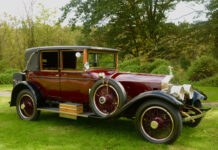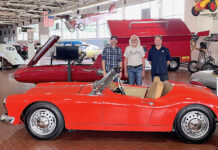By Jay Hirsch
The Lagonda Motor Company was founded in 1906 at Staines, a town in Surrey, England, by a Scottish-American, Wilbur Gunn, who was an opera singer.
Gunn was born in Shawnee, Ohio, in a settlement named Lagonda, which is now Springfield, Ohio. In 1891 Gunn returned to England and became a British national. Wilbur worked as a speedboat and motorcycle engineer in Staines and named his company Lagonda after the settlement where he was born in Ohio.
In 1905 a Lagonda motorcycle won the London-to-Edinburgh race, and in 1907 Gunn built his first Lagonda car. It was a 20-horsepower six-cylinder Torpedo, which won the Moscow-to-St.-Petersburg rally in 1910. This resulted in a large number of Lagondas being built for export to Russia, which lasted until the beginning of WWI in 1914.
In 1920 Wilbur Gunn died and Colin Parbury became the head of Lagonda.
Even though Lagondas were well-built cars they were also expensive. The financial effects of WWI on the 1920s European economy and the 1929 stock market crash in the United States made for a worldwide recession. By 1935 Lagonda was in financial trouble, and it was bought by Alan Good. Good persuaded W.O. Bentley to leave Rolls Royce and join Lagonda as a designer. Bentley also brought along members of his racing department staff at Rolls. While Rolls Royce was know for excellent luxury cars, the Bentley was known for its high-end performance automobile.
Bentley was Rolls Royce’s chief engineer. He had sold his company to Rolls in 1931, along with his name. At Lagonda, Bentley began work on a new V-12 engine, which was completed in 1937. It was a 4.5 liter/275 cid, 180-hp engine capable of going from 0-60 mph in 11 seconds and a top speed of 100 mph plus.
The Rapide, as the car with the V-12 was named, rode on 6.75 x 18 inch tires that were mounted on copper spooked wheels. The front was torsion bar-independent-suspension and the rear had leaf springs.
When this new V-12 was introduced in 1937, Rolls Royce swiftly took legal action against Lagonda as the V-12 engine was advertised as “W. O. Bentley’s Masterpiece!”
Bentley had made his company and his name in performance, something Rolls was not known for. Rolls did not want to see the Bentley name anywhere else and only associated with Rolls Royce, even though Bentley no longer was. While Bentley was known and seen as a sporty, expensive car. Rolls was known as a custom coached car and “stuffy.”
The trend in the car world of the 1920s and 1930s for people of wealth was to have your car custom-bodied or custom coach crafted. It was the game of one-upmanship. If a sea-going yacht was a sign of money, why not have a “land yacht” built of mahogany with wire-spooked copper wheels! All this on a Lagonda chassis with an OHC V-12.
The rear of the Rapide is a boat-tail, or sometimes called a tulip body. In the early part of the 20th century when the auto industry was just starting, there was the Model T Ford for the masses or an extravagant custom-coached car for the word rhymes with “masses” (as told to me by a friend who is not part of the masses). Mercedes-Benz had a few wooden-bodied sports type cars in 1910–1914. Although many cars used wood in their chassis and body structure the custom coach cars shaped the wood, which was steam bent just as it was done to boats and yachts. This was expensive and distinguished these vehicles from the ordinary, every day utilitarian motor car.
In the mid-1920s to early 1930s Rolls Royce also made some wood-bodied and wood-trimmed cars. Some had iron fenders with the rear being wooden or boat-tailed trimmed. But no car could compare to or compete with the V-12-powered Lagonda Rapide.
As for the ride, this is a 5,200-pound car with “modern-day front suspension,” so the ride is solid and smooth. The car was never built for “cornering,” as it was a different time period. The car was built for fair-weather cruising to your yacht or country club and to attract attention and have the fastest car in the parking area.
In 1939 the Lagonda was displayed at the New York Motor Show with a price of $8,900. In 1947 David Brown took over the reins at Lagonda, and Lagonda was merged with Aston Martin. •



